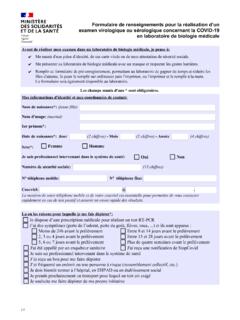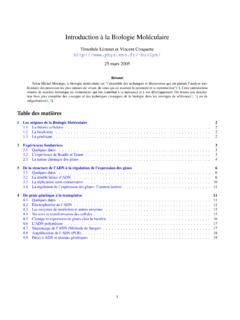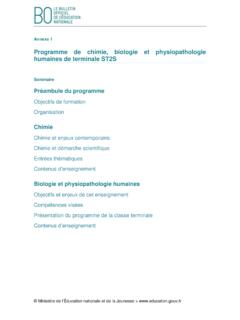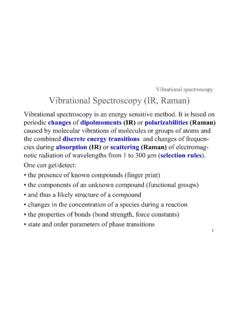Transcription of Proteins, Carbohydrates, and Lipids - Départment de biologie
1 3 Proteins, Carbohydrates, and Lipids Patrick Charnay : Morgane Thomas-Chollier : Site web compagnon livre Savada Life 9 me dition : #t_542578____ Proteins Proteins Biological molecules are polymers, constructed from the covalent binding of smaller molecules called monomers Proteins polymers are linear combination of amino acids monomers What Are the Chemical Structures and Functions of Carbohydrates? Carbohydrates have the general formula Cn(H2O)n 3 main roles: Source of stored energy Transport stored energy Carbon skeletons that can be rearranged to form new molecules What Are the Chemical Structures and Functions of Carbohydrates?
2 Monosaccharides: simple sugars =>monomer Disaccharides: two simple sugars linked by covalent bonds Oligosaccharides: three to 20 monosaccharides Polysaccharides: hundreds or thousands of monosaccharides starch, glycogen, cellulose What Are the Chemical Structures and Functions of Carbohydrates? All cells use glucose (monosaccharide) as an energy source. fuel of the living world Found for example in honey, fruits Figure From One Form of Glucose to the Other What Are the Chemical Structures and Functions of Carbohydrates?
3 All cells use glucose (monosaccharide) as an energy source. Exists as a straight chain or ring form. Ring is more common it is more stable. Ring form exists as - or -glucose, which can interconvert. What Are the Chemical Structures and Functions of Carbohydrates? Monosaccharides have different numbers of carbons: Hexoses: six carbons structural isomers Pentoses: five carbons Figure Monosaccharides Are Simple Sugars What Are the Chemical Structures and Functions of Carbohydrates? Monosaccharides bind together in condensation reactions to form glycosidic linkages.
4 Glycosidic linkages can be or . Figure Disaccharides Form by Glycosidic Linkages (Part 1) What Are the Chemical Structures and Functions of Carbohydrates? Often covalently bonded to proteins and Lipids on cell surfaces and act as recognition signals. Human blood groups get specificity from oligosaccharide chains. What Are the Chemical Structures and Functions of Carbohydrates? Polysaccharides are giant polymers of monosaccharides. Polysaccharides of glucose: Starch (amidon): storage of glucose in plants Glycogen: storage of glucose in animals Cellulose: very stable, good for structural components Figure Representative Polysaccharides (Part 1) Figure Representative Polysaccharides (Part 1) Figure Representative Polysaccharides (Part 2) What Are the Chemical Structures and Functions of Carbohydrates?
5 Carbohydrates can be modified by the addition of functional groups: Sugar phosphate Amino sugars (eg. Glucosamine) Chitin summary Proteins formed by a linear combination of amino acids monomers (among 20) by peptide linkage Carbohydrates formed by linear or branched combination of monosaccharides monomers by glycosidic linkage What Are the Chemical Structures and Functions of Lipids ? Lipids are nonpolar hydrocarbons. When sufficiently close together, weak but additive van der Waals forces hold them together. Not polymers in the strict sense, because they are not covalently bonded.
6 Aggregates of individual Lipids What Are the Chemical Structures and Functions of Lipids ? Fats and oils store energy Phospholipids structural role in cell membranes Carotenoids and chlorophylls capture light energy in plants (photoreceptor) Steroids and modified fatty acids hormones and vitamins Animal fat thermal insulation Lipid coating around nerves provides electrical insulation Oil and wax on skin, fur, and feathers repels water What Are the Chemical Structures and Functions of Lipids ? Fats and oils are triglycerides (simple Lipids ): composed of fatty acids and glycerol Glycerol: 3 OH groups (an alcohol) Fatty acid: nonpolar hydrocarbon with a polar carboxyl group Carboxyls bond with hydroxyls of glycerol in an ester linkage.
7 Figure Synthesis of a Triglyceride What Are the Chemical Structures and Functions of Lipids ? Saturated fatty acids: no double bonds between carbons it is saturated with H atoms. Unsaturated fatty acids: some double bonds in carbon chain. monounsaturated: one double bond polyunsaturated: more than one Figure Saturated and Unsaturated Fatty Acids (Part 1) Figure Saturated and Unsaturated Fatty Acids (Part 2) What Are the Chemical Structures and Functions of Lipids ? Animal fats tend to be saturated: packed together tightly; solid at room temperature.
8 Plant oils tend to be unsaturated: the kinks prevent packing; liquid at room temperature. What Are the Chemical Structures and Functions of Lipids ? Fatty acids are amphipathic: they have opposing chemical properties. When the carboxyl group ionizes it forms COO and is strongly hydrophilic; the other end is hydrophobic. What Are the Chemical Structures and Functions of Lipids ? Phospholipids: fatty acids bound to glycerol; a phosphate group replaces one fatty acid. Phosphate group is hydrophilic the head Tails are fatty acid chains hydrophobic They are amphipathic Figure Phospholipids (Part 1) What Are the Chemical Structures and Functions of Lipids ?
9 In water, phospholipids line up with the hydrophobic tails together and the phosphate heads facing outward, to form a bilayer. Biological membranes have this kind of phospholipid bilayer structure. Figure Phospholipids (Part 2) Figure -Carotene is the Source of Vitamin A Carotenoids: light-absorbing pigments Figure All Steroids Have the Same Ring Structure Steroids: multiple rings share carbons What Are the Chemical Structures and Functions of Lipids ? Vitamins small molecules not synthesized by the body and must be acquired in the diet.
10 Not all vitamins are Lipids ! => vitamin A, K, D, E summary Proteins formed by a linear combination of amino acids monomers (among 20) by peptide linkage Carbohydrates formed by linear or branched combination of monosaccharides monomers by glycosidic linkage Lipids form large structures but the interactions are not covalent. Non polar and amphiphatic molecules 3 Nucleic Acids and the Origin of Life What Are the Chemical Structures and Functions of Nucleic Acids? Nucleic acids are polymers specialized for the storage, transmission, and use of genetic information.







